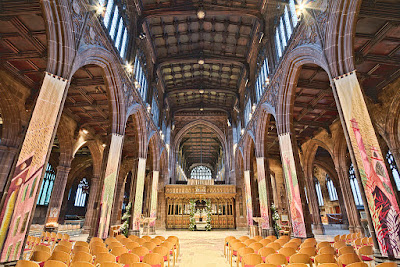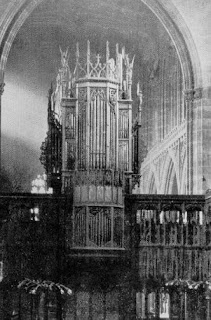 |
| Manchester Cathedral nave, before the current building works |
At the moment the rood screen is being prepared and is covered in scaffolding. So Sung Eucharist took place in the nave, well forward of the screen, with the choir placed at the side adjacent to the console of the replacement, electronic organ. Acoustics were not ideal, and from where we sat we heard rather more of Geoffrey Woolatt's excellent organ playing than the choir. Directed by Christopher Stokes, the choir consisted of six men and around a dozen or so trebles (mainly girls with one or two boys). The opening introit, Byrd's Haec Dies was sung from the rear of the choir, and the admirably clear focussed sound of the trebles gave me no hint whether they were boys or girls, an excellent blind test.
 |
| The historic organ at Manchester Cathedral |
I remember services at Manchester Cathedral from my student days, combining ceremonial with an element of approachable informality, and this has evidently continued. The president was the Very Reverend Rogers Govender, Dean of Manchester Cathedral, and the Bishop of Manchester, the Right Reverend David Walker gave a thought provoking sermon. After the service we were able to wander round to see the installations by artist Julian Stair, a series of highly evocative pots, part of a Lent trail in Manchester linking art and religion.
The church only became a cathedral in the mid 19th century, but the church is finely historical (though most of the stonework was replaced in the 19th century). It was originally rebuilt in the 15th and 16th century with a fine surviving set of choir stalls alongside the screen. Thanks to the preponderance of chantry chapels in the medieval period it has one of the widest naves in the UK; when the chantries were dissolved during the reformation, the screens dividing them were removed giving the church the appearance of being double aisled.
You can support the Manchester Cathedral organ appeal at their website.



%20and%20kids.jpg)
.webp)





.jpg)
No comments:
Post a Comment